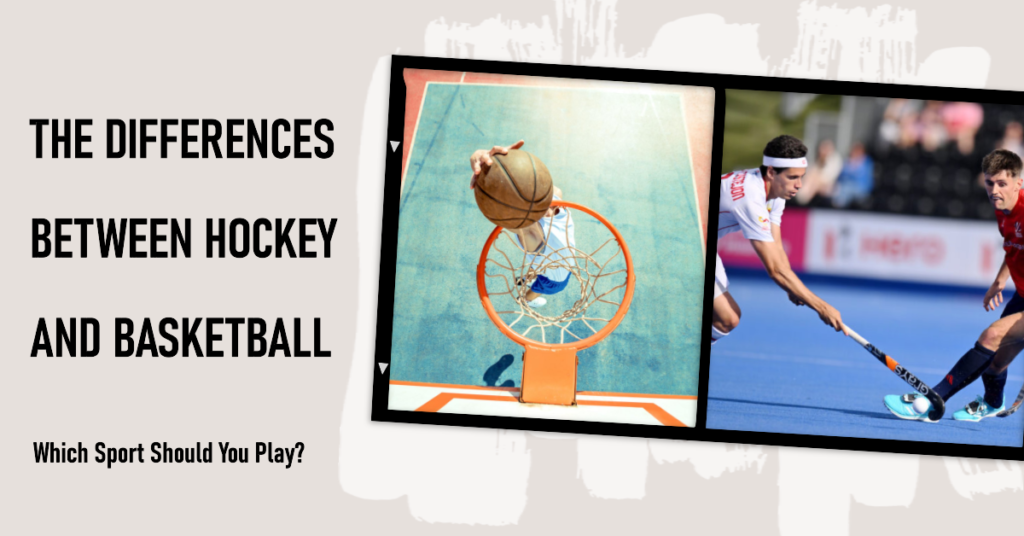Hockey and basketball are both popular sports with unique gameplay and rules. In hockey, players use sticks to hit a puck into the opponent’s net, while basketball involves shooting a ball into a hoop.
These sports offer distinct experiences for athletes and fans alike.
A Brief History
The fascinating history of hockey and basketball unveils their distinct origins and evolution, showcasing their unique qualities and lasting impact on sports culture. The contrasting nature of these two beloved sports highlights the diverse fanbase and strategic gameplay that make them timeless favorites.
Hockey Vs Basketball:
Hockey and basketball are popular sports that millions of fans worldwide have enjoyed. Both sports have unique origins and have evolved into the thrilling games we know today.
Origins And Evolution Of Hockey:
- Hockey can be traced back to ancient times when it was played by civilizations such as the Egyptians, Persians, and Greeks. These early game versions involved using sticks to hit a ball or object.
- The modern game of hockey, as we know it, originated in the 19th century in Canada. The first organized indoor hockey game took place in Montreal in 1875.
- The sport quickly gained popularity and spread to other countries, including the United States, Europe, and Asia. It continues to be a popular winter sport globally, with professional leagues and international competitions attracting passionate fans.
Origins And Evolution Of Basketball:
- Basketball, on the other hand, is a relatively newer sport compared to hockey. Dr. James Naismith invented it in December 1891 to keep his students active during winter at the International YMCA Training School in Springfield, Massachusetts, USA.
- The original game involved peach baskets and a soccer ball, replaced by proper hoops and a distinctive basketball in subsequent years.
- Basketball gained popularity rapidly, and within a decade, it became an official Olympic sport. Today, it is played at various levels, from recreational leagues to professional competitions worldwide.
Comparing the popularity of the sports globally:
Hockey and basketball have amassed substantial fan bases worldwide, but their popularity varies by region.
- Hockey is especially popular in North America, Canada, and the United States. It is ingrained in the culture of these countries and enjoys a large following.
- Basketball, on the other hand, has a more global appeal. It is trendy in the United States and has gained significant traction in Europe, Africa, and Asia. The National Basketball Association (NBA) is the premier professional league for basketball, attracting fans from all around the globe.
Both hockey and basketball have evolved significantly from their early origins. They have captured the hearts of fans worldwide, with each sport having its unique appeal. Whether it is the fast-paced action of hockey or the skillful maneuvers on the basketball court, these sports continue to captivate audiences and inspire future generations of athletes.
Gameplay And Rules
Hockey and basketball have distinct gameplay and rules. Hockey involves skating and handling a puck, while basketball focuses on dribbling and shooting a ball. Each sport has unique laws regarding scoring, fouls, and game duration. Compare and contrast the gameplay and practices of these two exciting sports.
Hockey:
Hockey is an exhilarating sport played on a specialized field with unique equipment. The gameplay and rules in hockey require skill, strategy, and teamwork. Let’s delve into it further:
Field And Equipment:
- Hockey is played on a rectangular field with artificial turf or grass, typically 91.4 meters long and 55 meters wide.
- The field is divided into two halves by a centerline, and both ends have a goal cage.
- Each player is equipped with a stick, usually made of wood or composite materials, to control and strike the ball.
Rules And Scoring:
- Hockey aims to score goals by hitting the ball into the opponent’s goalcage.
- Players move the ball using their sticks and must not use their feet or other body parts to control it.
- Each team consists of 11 players, including a goalkeeper.
- The game consists of two halves, each lasting 35 minutes, with a 5-10 minute halftime break.
- Fouls, such as obstruction or dangerous play, lead to penalties or free spaces for the opposing team.
- Goals are scored when the ball completely crosses the goal line between the goalposts and beneath the crossbar.
Key Positions And Player Roles:
- Goalkeeper: The last line of defense, preventing the opposing team from scoring.
- Defenders: Their primary role is to protect their team’s goal and intercept or tackle opponents to regain possession.
- Midfielders: Act as connectors between defenders and forwards, building attacks and maintaining possession.
- Forwards: Their primary focus is to score goals by positioning themselves strategically and coordinating attacks with teammates.
Basketball:
Basketball is a fast-paced and dynamic sport played on a rectangular court. The gameplay and rules in basketball emphasize agility, precision, and collaboration. Let’s explore them further:
Court And Equipment:
- Basketball is played on a standard court with a rectangular surface measuring 28 meters long and 15 meters wide.
- The court is divided into two halves by a midcourt line, with two hoops at opposite ends.
- Each player wears appropriate sports attire and basketball shoes to enhance their mobility and grip on the court.
Rules And Scoring:
- The objective of basketball is to score points by shooting the ball into the opponent’s hoop while preventing them from achieving on their own.
- Players dribble the ball with their hands and cannot travel (take steps without dribbling) or double dribble (dribble with both hands simultaneously).
- Each team consists of five players, including positions like point guard, shooting guard, small forward, power forward, and center.
- The game is divided into four quarters, each lasting 10 minutes, with a short break between the first and second quarters and a more extended halftime break.
- Fouls committed by players lead to free throws or possession awarded to the opposing team.
- Points are scored by throwing the ball into the hoop; different shots carry varying point values, such as two points for a field goal and one for a free throw.
Key Positions And Player Roles:
- Point Guard: Mainly responsible for directing the team’s offense, setting up plays, and initiating attacks.
- Shooting Guard: Primarily focuses on scoring, often positioned on the wings to shoot from mid-range or beyond the three-point line.
- Small Forward: Combines attributes of guards and forwards, playing both offensively and defensively, often involved in rebounds and assists.
- Power Forward: Primarily focuses on scoring, rebounding, and defending near the basket, playing close to the hoop.
- Center: Often the tallest player, responsible for defending the rim, rebounding, and scoring close to the basket.
Hockey and basketball offer unique gameplay experiences with their field/court dimensions, equipment, rules, scoring, and player roles. Whether you prefer the thrill of hockey or the fast-paced action of basketball, both sports provide excitement and showcase the skills of talented athletes.
Physical Demands And Skills
Hockey and basketball require different physical demands and skills. While hockey demands agility and quick reflexes on ice, basketball requires speed and precision. Both sports test endurance, coordination, and teamwork.
Hockey:
Aerobic Endurance And Stamina:
- Players in hockey require high levels of aerobic endurance and stamina to keep up with the fast-paced nature of the game.
- The continuous movement on the ice, combined with short shifts and quick bursts of energy, demands exceptional cardiovascular fitness.
- Skating for long periods requires players to have a robust stamina foundation.
Speed And Agility:
- Hockey is known for its fast-paced action, and speed is a crucial skill for players.
- Swift skating lets players cover the ice quickly, making rapid plays and creating scoring opportunities.
- Agility plays a vital role in a player’s ability to maneuver and change direction swiftly, allowing them to avoid opponents and make seamless transitions.
Stickhandling And Shooting Skills:
- Effective stickhandling is a fundamental aspect of hockey, allowing players to control the puck while maneuvering around opponents.
- Players with exceptional stickhandling skills can quickly change direction, deke out opponents, and set up scoring chances.
- Shooting skills are paramount for players to score goals. Accurate shooting techniques, such as wrist shots, slap shots, and backhands, can distinguish between winning and losing.
Basketball:
Agility And Quickness:
- In basketball, agility, and quickness are vital attributes that allow players to navigate the court efficiently.
- Agile players can change direction swiftly, evade defenders, and create scoring opportunities.
- Quickness lets players react promptly, steal the ball, defend effectively, and make agile cuts during offensive plays.
Jumping And Verticality:
- Basketball heavily emphasizes jumping ability, as players frequently jump to shoot, rebound, or block shots.
- Verticality, or the ability to leap high, dramatically enhances a player’s effectiveness in the game’s offensive and defensive aspects.
- A solid vertical leap allows players to grab rebounds, block shots, and score points near the basket.
Dribbling And Shooting Skills:
- Mastering dribbling techniques is essential in basketball, enabling players to navigate the court while maintaining control of the ball.
- Skilled dribblers can execute crossovers, spin moves, and hesitation dribbles to confuse defenders and create scoring opportunities.
- Shooting skills, including layups, jump shots, and three-pointers, determine a player’s scoring prowess and overall offensive impact.
Physical demands and skills play integral roles in a player’s performance in both hockey and basketball. Players can excel in these dynamic and fast-paced sports by honing their aerobic endurance, stamina, speed, agility, stickhandling, shooting, dribbling, and jumping abilities.
Strategy And Tactics
Hockey and basketball employ different strategies and tactics, each with its unique style of play. While hockey emphasizes physicality and teamwork, basketball focuses on agility and skill. Both sports offer a thrilling experience for fans and players alike.
Hockey:
Hockey is a fast-paced sport requiring teams to employ effective strategies and tactics to gain an advantage over opponents. Let’s dive into some critical aspects of design and tactics in hockey.
Offensive And Defensive Formations:
- Neutral Zone Trap: This defensive formation involves clogging up the middle of the neutral zone to slow down the opposing team’s progress and force turnovers. It requires good positioning and quick transitions.
- Forechecking: This offensive formation involves putting pressure on the opposing team’s defensemen as they try to gain control of the puck. It can create turnovers and scoring opportunities.
- Man-to-Man Defense: This defensive formation assigns a defenseman to cover each opposing player. It requires good communication and positioning to prevent scoring chances.
Powerplays And Penalty Kills:
- Powerplay: When a team has a man advantage due to an opponent’s penalty, they employ a powerplay strategy. This involves utilizing extra players to create scoring opportunities and maintaining possession of the puck.
- Penalty Kill: When a team is short-handed due to their penalty, they employ a penalty kill strategy. This involves pressuring the opposing team, blocking passing lanes, and clearing the puck to prevent goals.
Coaching And Game Plans:
- Line Matchups: Coaches strategically match their lines against the opposing team’s lines based on strengths, weaknesses, and game situations. This helps exploit favorable matchups.
- In-game Adjustments: Good coaches make on-the-fly adjustments to their game plans based on the game’s flow. This may involve changing lines, defensive pairings, or strategies to counter the opponent’s tactics.
Basketball: Strategy And Tactics
Basketball is a dynamic sport that relies heavily on strategy and tactics. Let’s explore some of the critical elements of basketball strategy.
Offensive Plays And Strategies:
- Pick and Roll: This offensive play involves a player setting a screen (pick) for the ball handler, who then uses the screen to drive to the basket or create scoring opportunities for themselves or a teammate.
- Fastbreak: This offensive strategy focuses on quickly advancing the ball up the court to catch the defense off guard. It often leads to accessible scoring opportunities before the reason can be set up.
- Motion Offense: This offensive strategy involves constant player movement and passing to create open shots. It requires good spacing, timing, and communication.
Defensive Schemes And Traps:
- Man-to-Man Defense: This defensive scheme assigns each defender to guard a specific opponent. It requires good communication, quick rotations, and the ability to contain the opposing players.
- Zone Defense: This defensive scheme involves players guarding specific areas on the court rather than individual opponents. It can disrupt an opponent’s offensive flow and force them into tough shots.
- Full-court Press: This defensive trap pressures the opposing team’s ball handlers throughout the court, forcing turnovers and rushed decisions.
Coaching And Game Preparation:
- Scouting: Coaches analyze opponents’ strengths and weaknesses to develop game plans. This includes studying game footage, statistical analysis, and identifying key players and strategies to counter.
- Timeout Usage: Coaches strategically use timeouts during a game to make adjustments, provide rest, and motivate players.
As you can see, hockey and basketball require teams to employ various strategies and tactics to succeed. Whether it’s offensive formations, powerplays, or defensive schemes, coaches play a crucial role in devising game plans that give their teams an edge.
So, next time you watch a hockey or basketball game, pay attention to the strategy and tactics unfolding on the ice or court.
Physical Contact And Injuries
Hockey and basketball differ in terms of physical contact and injuries. While both sports involve high levels of physicality, hockey tends to have more full-body contact and a higher risk of injuries, such as concussions and fractures, than basketball.
The physical demands of each sport contribute to their unique gameplay and injury patterns.
Hockey:
Checking And Physicality:
- Hockey is known for its high level of physical contact, with players checking to gain possession of the puck.
- Checking is an integral part of the game, where players use their bodies to block, push, or hit opponents to gain an advantage.
- It requires strength, agility, and the ability to anticipate and withstand physical collisions.
Common Injuries And Safety Measures:
- Due to the physical nature of hockey, injuries are common among players.
- Common injuries include concussions, sprains, strains, cuts, and fractures.
- Safety measures such as wearing proper protective gear, including helmets, mouthguards, and pads, are essential to minimize the risk of injury.
- Regular inspections and equipment maintenance also play a crucial role in ensuring player safety.
Long-Term Health Implications:
- Despite taking necessary precautions, hockey players may experience long-term health implications.
- Even with helmets, repeated blows to the head can lead to concussions and potentially long-term cognitive issues.
- Physical wear and tear on joints, particularly in the knees and hips, can result in chronic pain and arthritis.
- Proper training, conditioning, and rehabilitation programs can help minimize the long-term impact of these injuries.
Basketball:
Fouls And Physical Contact Rules:
- While basketball is a non-contact sport, physical contact is unavoidable due to the nature of the game.
- Fouls are called to penalize excessive or illegal physical contact, such as pushing, holding, or charging into opponents.
- The rules of the game aim to maintain a balance between physicality and player safety.
Common Injuries And Safety Measures:
- Basketball players can be prone to various injuries, including sprains, strains, ankle twists, and knee injuries.
- Landing awkwardly after jumping, sudden changes in direction, or collisions with other players can cause these injuries.
- Wearing proper footwear, warming up before games, and using protective braces can help prevent injuries.
- Regular strength and conditioning exercises can also contribute to injury prevention.
Long-Term Health Implications:
- While the risk of severe long-term health implications is relatively low in basketball compared to contact sports like hockey, there are still potential concerns.
- Frequent jumping and high-impact movements can lead to wear and tear on joints over time, potentially resulting in chronic pain or orthopedic issues.
- Maintaining a balanced training program, focusing on strength, flexibility, and recovery can help minimize the risk of long-term health problems in basketball players.
Remember, the physicality in hockey and basketball brings its fair share of injuries and potential long-term health concerns. By prioritizing safety and taking preventive measures, athletes and sports organizations can ensure players’ well-being in each sport.
Popularity And Global Reach
Hockey and basketball have both gained immense popularity and global reach. These sports attract millions of fans worldwide, with each offering its own unique set of skills and thrills on the playing field. Whether it’s the fast-paced action of hockey or the high-flying excitement of basketball, both sports captivate audiences around the globe.
Hockey:
Popular leagues and tournaments around the world:
- National Hockey League (NHL): The NHL is undoubtedly the most popular hockey league globally, showcasing the best players from North America and boasting a massive fan base.
- Kontinental Hockey League (KHL): The KHL, based in Eurasia, is the second-largest professional hockey league and attracts top talent from Russia, Finland, and other European countries.
- International Ice Hockey Federation (IIHF) World Championships: The IIHF organizes annual international tournaments, attracting teams worldwide and generating immense excitement among fans.
Cultural impact in different countries:
- Canada: Hockey is deeply rooted in Canadian culture and is considered the national sport, with devoted fans and widespread participation at all levels.
- Russia: Hockey is special in Russian culture, with a rich history and passionate support for club and national teams.
- Sweden: Known for its strong hockey program, Sweden embraces the sport enthusiastically, producing many top-tier players and enjoying a thriving professional league.
Growth of the sport globally:
- Expansion into non-traditional hockey markets: Hockey’s popularity has expanded beyond its traditional strongholds, with countries like China, Japan, and the United Arab Emirates investing in developing their hockey programs.
- Increased media coverage and accessibility: The availability of hockey broadcasts, both online and on television, has increased significantly, making the sport more accessible to fans globally.
- Growing participation: With the growth of grassroots initiatives and the inclusion of hockey in school programs, more people are taking up the sport, leading to an increase in the global hockey community.
Basketball:
Popular leagues and tournaments around the world:
- National Basketball Association (NBA): The NBA is the most well-known and elite basketball league globally, featuring the world’s top players and attracting a massive following.
- FIBA Basketball World Cup: Organized by the International Basketball Federation (FIBA), the Basketball World Cup brings together national teams from different countries in an exciting tournament.
- EuroLeague: The EuroLeague showcases the best basketball talent in Europe, providing fierce competition and captivating fans on the continent.
Cultural impact in different countries:
- United States: Basketball holds immense cultural significance in the US, with the NBA becoming a cultural phenomenon and basketball being widely played at amateur and recreational levels.
- China: The popularity of basketball has skyrocketed in China, with the NBA gaining a massive fan base and Chinese players making their mark in domestic and international competitions.
- Philippines: Basketball is deeply ingrained in Filipino culture, with the sport being widely played and embraced by fans, creating a passionate basketball community.
Growth of the sport globally:
- Globalization of the NBA: The NBA’s global outreach efforts, with games and events held internationally, have contributed to the growth of basketball’s popularity and increased participation worldwide.
- Olympic inclusion: Basketball’s inclusion in the Olympic Games has significantly contributed to its growth globally, exposing the sport to a broader audience and generating interest in different countries.
- Grassroots development programs: Various organizations and initiatives have focused on introducing basketball at the grassroots level, fostering the sport’s growth, and creating opportunities for young players worldwide.
Both hockey and basketball have garnered popularity and a global reach through their respective leagues and tournaments. While hockey’s cultural impact can be seen in nations like Canada, Russia, and Sweden, basketball has significantly impacted the United States, China, and the Philippines.
With the expansion of the sports into non-traditional markets, increased media coverage, and growing participation, hockey and basketball continue to thrive and captivate fans worldwide.
Fan Experience And Atmosphere
Experience the electrifying atmosphere of Hockey and Basketball games as fans come together to cheer on their teams. Witness passionate crowds, roaring chants, and the energy that fills the arena, creating unforgettable moments for sports enthusiasts. Discover the unique fan experiences that make these two sports truly special.
Hockey: Arena Atmosphere And Traditions
- The arena atmosphere in hockey games is often described as electrifying and intense, with fans passionately cheering for their teams.
- Pre-game rituals and traditions add to the excitement, such as playing the national anthem, the ceremonial puck drop, and the roaring sound of the crowd.
- The presence of the team mascot, cheerleaders, and enthusiastic ice girls further enhances the overall experience.
Hockey: Team Rivalries And Fan Loyalty
- Hockey is known for its intense rivalries between teams, which create an electrifying atmosphere in the arena. Fans from opposing teams passionately support their sides, leading to exciting, heated matchups.
- The deep-rooted team loyalties in hockey are often passed down through generations. Fans proudly wear their team jerseys or colors, creating a sea of enthusiastic supporters in the arena.
- Fans highly anticipate rivalry games, and the intense competition on the ice fuels the passionate atmosphere, making hockey games a thrilling experience for die-hard supporters and casual spectators.
Hockey: Viewing Experience And Game Day Rituals
- Watching a hockey game live provides a unique and immersive experience. The fast-paced nature of the sport, combined with the physicality and skill of the players, keeps fans on the edge of their seats.
- Game day rituals are an integral part of the hockey experience. From tailgating in the parking lot to enjoying pre-game festivities, fans come together to celebrate their love for the sport and their favorite team.
- Chanting team chants, participating in the wave, and engaging in friendly banter with rival fans all contribute to the energetic atmosphere of a hockey game.
Basketball: Stadium Atmosphere And Traditions
- Basketball games create a vibrant atmosphere in the stadium, with fans cheering, chanting, and making an electric energy throughout the game. The fast-paced action on the court adds to the thrill of the experience.
- In basketball, traditions like introducing the starting lineup, the halftime show, and the dunk contest during All-Star games add excitement and entertainment value to the overall fan experience.
- Many basketball stadiums also have their unique traditions. For example, the “Loud City” in Oklahoma City, where fans cheer and create a loud noise level to support their team, is known for its lively atmosphere.
Basketball: Team Rivalries And Fan Loyalty
- Basketball rivalries add an extra spice to the game, with teams battling it out on the court and fans passionately supporting their respective sides. Games between rival teams often generate intense emotions and fierce competition.
- Fan loyalty in basketball is evident in the sea of team colors and jerseys, with supporters proudly displaying their allegiance. The passionate chants and cheers from fans contribute to the electrifying atmosphere in the stadium.
- The rivalries between teams often stretch beyond the court, with fans engaging in friendly banter and debates about their favorite teams’ success and achievements.
Basketball: Viewing Experience And Game Day Rituals
- Attending a basketball game offers a captivating viewing experience, with high-flying dunks, skillful plays, and buzzer-beating shots keeping fans engaged and entertained throughout the match.
- Game day rituals in basketball often revolve around pre-game warm-ups and player introductions. Fans eagerly anticipate these moments, awaiting their favorite players’ appearance on the court.
- The halftime entertainment, including performances by dance teams, mascots, and even famous artists, adds to the overall enjoyment and spectacle of the game.
In both hockey and basketball, the fan experience and atmosphere are unforgettable. The intense rivalries, unwavering loyalty, and unique game-day traditions create a game-terrifying atmosphere that keeps fans returning for more. Whether it’s the raucous cheers in a hockey arena or the lively chants in a basketball stadium, the passion and excitement of these sports make watching live games an extraordinary experience.
Frequently Asked Questions Of Hockey Vs Basketball
What Sport Is Harder, Hockey Or Basketball?
Hockey and basketball are challenging sports, but their difficulty level may vary depending on individual preferences and skills.
What Is More Popular Hockey Or Basketball?
Hockey and basketball are popular sports, but their popularity can vary depending on location and personal preferences.
Is Hockey One Of The Hardest Sports?
Yes, hockey is considered one of the most challenging sports due to its physicality and skill requirements.
Is It Harder To Make The NHL or NBA?
Making the NBA is more complicated than making the NHL due to more competition and fewer roster spots.
Conclusion
Whether you prefer hockey or basketball, these two sports offer a unique and thrilling experience for fans and participants alike. Hockey excels in its fast-paced nature, physicality, and tense atmosphere, while basketball showcases incredible athleticism, strategic gameplay, and high-scoring action.
Both sports require skill, teamwork, and dedication but offer distinct dynamics on the ice or court. Regardless of personal preference, it is clear that both hockey and basketball have a rich history and continue to captivate audiences worldwide. So, whether you’re a die-hard hockey fan or a devoted basketball enthusiast, there’s no denying the excitement and passion that these sports bring.
So, go out and support your favorite team, and revel in the joy and camaraderie that sports can bring to our lives.






